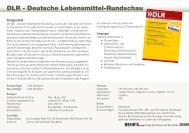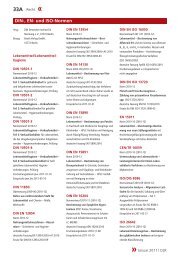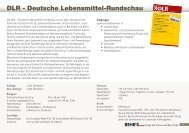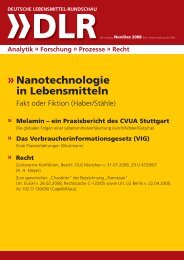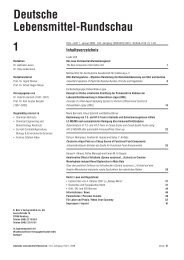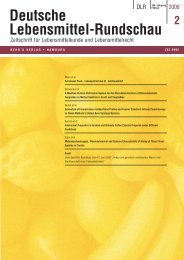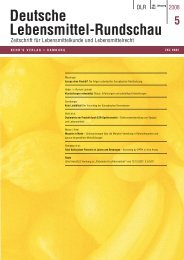Der GMOfinder - DLR Online: Deutsche Lebensmittel Rundschau
Der GMOfinder - DLR Online: Deutsche Lebensmittel Rundschau
Der GMOfinder - DLR Online: Deutsche Lebensmittel Rundschau
Erfolgreiche ePaper selbst erstellen
Machen Sie aus Ihren PDF Publikationen ein blätterbares Flipbook mit unserer einzigartigen Google optimierten e-Paper Software.
» Sonderthema: Mikrobiologische Methoden in der <strong>Lebensmittel</strong>analytik 653<br />
tection to help determine the source<br />
of the contamination. And, the system<br />
does all this with a ready-to-use medium<br />
that is simply combined with a water<br />
sample.<br />
Many users may stop after detecting<br />
coliforms. Detecting any coliforms in the<br />
sample is enough for them to indicate that<br />
further action is required. But, the test<br />
makes it very easy to take the next step<br />
if coliforms have been found. Using the<br />
same sample, simply use a long wavelength<br />
ultraviolet light in a darkened environment<br />
to check for fluorescence. If<br />
the sample produces a bright blue fluorescence,<br />
the coliforms that have been detected<br />
include MUG-positive E. coli bacteria.<br />
For users solely interested in detecting<br />
fecal coliforms, the Colitag system includes<br />
a procedure that utilizes a 20-hour<br />
incubation at 44.5°C to exclude non-fecal<br />
coliforms from detection. Both MUG positive<br />
and MUG negative E. coli can be further<br />
identified through the use of ultraviolet<br />
light and Kovac’s reagent.<br />
Within the fecal coliforms procedure,<br />
if the sample has turned yellow and no<br />
bright blue fluorescence has been seen<br />
to indicate the presence of MUG-positive<br />
E. coli, the sample can be further tested<br />
for MUG-negative E. coli. To test for MUGnegative<br />
E. coli, add a few drops of Kovac’s<br />
reagent to the sample. If a reddish purple<br />
Detecting coliforms and E. coli in water<br />
samples using Colitag<br />
1. Start with a 100 mL water sample. If the sample is chlorinated,<br />
add 10 mg of sodium thiosulfate to neutralize the chlorine.<br />
2. Add the entire contents of a premeasured vial of medium. Mix<br />
briefly to dissolve the medium, and place the sample into an incubator<br />
set at 35°C for 24 hours.<br />
3. After the incubation, check the sample for a vibrant yellow color.<br />
If the sample is yellow, coliforms are present. If the sample has<br />
remained colorless, the test has not detected even one coliform<br />
in the 100 mL sample.<br />
colour forms on the surface of the water,<br />
the sample is positive for MUG-negative<br />
E. coli.<br />
How does the system so easily detect coliforms<br />
and E. coli? The system’s medium is<br />
engineered to detect enzymes characteristic<br />
of E. coli and the coliform group. Resuscitation<br />
of target organisms is accomplished<br />
through a patented technology,<br />
which combines a low pH medium and<br />
nutrients that provide a favorable environment<br />
for resuscitation of weak or injured<br />
cells.<br />
After the bacteria are rejuvenated at<br />
this low pH, the medium adjusts the pH to<br />
a neutral level. This rise in pH aids growth<br />
of E. coli cells to levels more readily detected.<br />
In addition, this rise in pH makes<br />
it easier to see the system’s colour and<br />
luorescence indicators.<br />
Erkrankungen durch<br />
Nahrungs- und Genussmittel<br />
Ursachen – Diagnostik –<br />
Therapie – Prävention<br />
Herausgegeben von Prof. Dr. Dr.<br />
Jürgen Stein, Prof. Dr. Martin<br />
Raithel, und Prof. Dr. Manfred Kist.<br />
2011. XVIII, 510 S. 122 Abb., 79 Tab.<br />
Gebunden. € 78,– [D]<br />
ISBN 978-3-8047-2565-2<br />
E-Book PDF: € 78,– [D]<br />
ISBN 978-3-8047-2969-8<br />
E-Books sind online als PDF zum Download<br />
erhältlich unter www.buchoffizin.de<br />
Renommierte Ernährungswissenschaftler und -mediziner,<br />
Pharmazeuten, Gastroenterologen und Infektiologen<br />
stellen in diesem umfangreichen Werk alle Aspekte<br />
nahrungs- und genussmittelbedingter Erkrankungen<br />
systematisch dar.<br />
Fundierte Informationen über Ursachen und<br />
Pathogenese, Klassifikation und Epidemiologie,<br />
Diagnostik und Therapie sowie Prävention so gut<br />
wie aller ernährungsbedingten Krankheiten ermöglichen<br />
dem Leser eine bedarfsgerechte, individuelle Behandlung<br />
auch außergewöhnlicher Fälle.<br />
„Essen ist ein Bedürfnis, Genießen ist eine Kunst.”<br />
(François de La Rochefoucauld)<br />
Wissenschaftliche<br />
Verlagsgesellschaft Stuttgart<br />
<strong>DLR</strong> | Dezember 2012 «<br />
Birkenwaldstr. 44 · 70191 Stuttgart · Tel. 0711 2582 341 · Fax 0711 2582 390<br />
servicewissenschaftliche-verlagsgesellschaft.de · www.wissenschaftliche-verlagsgesellschaft.de




